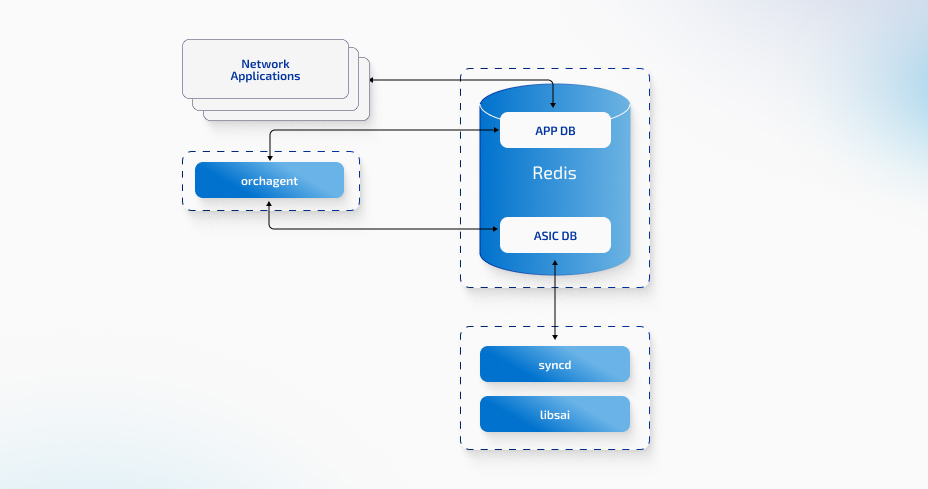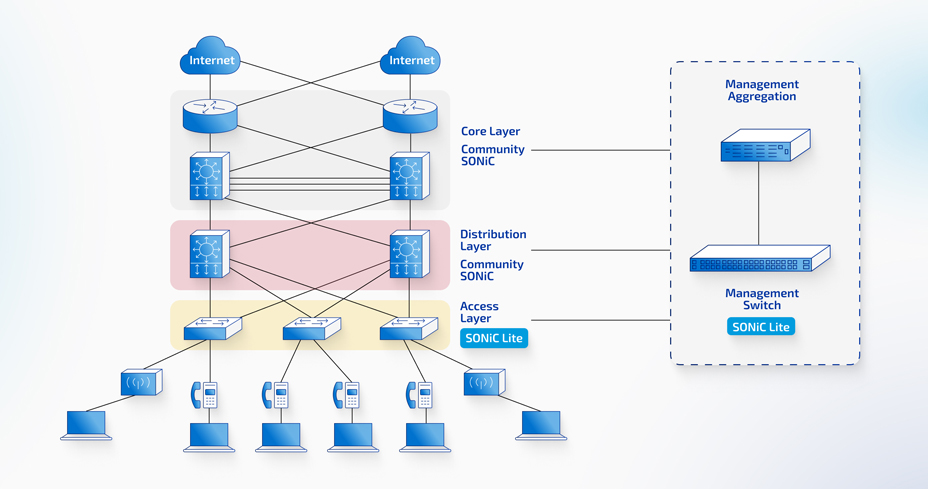While no single solution is a perfect fit for every network, SONiC offers a powerful and adaptable open-source NOS foundation. Community SONiC has a long history of development in data centers (DC). However, hardening it for your specific network environment is crucial for successful implementation.
SONiC adoption for Telco lags behind other network types. You may need to create your own distribution by adding missing components to address telecom-specific requirements, which often extend beyond typical DC needs and involve additional engineering effort.
Traditional SONiC versions can be overkill for campus and edge networks, which prioritize a limited set of features and support for mandatory protocols. For these deployments, SONiC Lite offers a lightweight solution specifically designed for access and management switches, perfectly suited to this use case.
This article will guide you through selecting the right version of SONiC for your specific needs. We will delve into the potential challenges of compatibility, integration, and support, enabling you to navigate these complexities and achieve a successful SONiC deployment for your unique use case.
CONTENTS
SONiC: Ideal NOS for Disaggregation and Openness
The open networking movement, with its adoption of open NOSs, has surged in popularity. Among these solutions, SONiC (Software for Open Networking in the Cloud) stands out as a leader.
SONiC has transformed networking by delivering flexibility, cost reductions, and innovation. Initially embraced by hyperscalers, SONiC is now gaining traction with enterprises and service providers seeking to optimize their networks.
Use cases prioritizing disaggregation and open NOS, like DC, edge, AI, and Telco, benefit most from SONiC. In contrast to traditional closed systems, SONiC’s open architecture fosters innovation and interoperability. Additionally, the combination of white-box switches using standard merchant silicon and free, open-source software dramatically reduces costs. This approach delivers the same features and support as traditional vendors, but at a fraction of the price, leading to substantial CapEx and OpEx savings.
Download our white paper to learn more about SONiC's capabilities and unlock its potential for your business. Discover how SONiC can revolutionize your network infrastructure, offering unparalleled flexibility, scalability, and cost optimization.
SONiC leverages a Switch Abstraction Interface (SAI) to ensure compatibility across different network switch hardware. An SAI acts as a common language between an NOS and the underlying switch hardware (ASICs) from various vendors like Broadcom, NVIDIA, Marvell, Cisco, Intel, etc. This standardization simplifies development and deployment for both SONiC and switch manufacturers.
 SAI from SONiC Perspective
SAI from SONiC Perspective
The Open Compute Project (OCP) fosters collaboration between hardware and software developers. This co-design approach guarantees continuous improvement of the hardware abstraction layer, further strengthening SONiC’s versatility.
Managing SONiC: Challenges and Mitigation Strategy
While major companies like LinkedIn, Microsoft, eBay, and Target have successfully adopted SONiC, deployment complexity can be a concern due to several reasons:
- Vendor Fragmentation: Each vendor provides its own version of SONiC with unique configurations, management tools, and interfaces. This creates complications for managing and monitoring a network with diverse hardware.
- Compatibility Concerns: Vendor updates to SONiC can introduce compatibility issues with other network components, requiring additional testing and potentially causing disruptions.
- Integration Challenges: Differences in SONiC versions across vendors can lead to inconsistencies in configuration and telemetry data, making network integration difficult.
- Inconsistent Support: The level of support varies by vendor. This inconsistency can complicate troubleshooting network issues.
- Increased Training Needs: Operators may require additional training to understand the specific hardware and software nuances of each vendor’s SONiC implementation, leading to longer onboarding times.
Implementing SONiC requires careful consideration, planning, and skilled personnel with a deep understanding of its architecture. The first step is understanding your network’s unique demands. What functionalities are crucial for your day-to-day operations? Is your organization keen on cutting-edge features or does it prioritize the proven reliability of a mature release? With different SONiC versions offering varying capabilities, you can make choices that prioritize your must-have features.
Selecting the right SONiC version is just the beginning. It is best to conduct a thorough assessment of SONiC’s technical capabilities and its viability within your specific network infrastructure. Don’t rely solely on the community version. Rigorous testing of vendor-specific SONiC builds for functionality, performance, and scalability across your chosen platforms and use cases is essential.
Beyond the initial assessment, consider how SONiC aligns with your specific needs. Different versions offer varying features, so ensure the chosen version possesses the features crucial for your network infrastructure. Additionally, leverage SONiC’s strength in hardware compatibility. Many vendors bundle hardware with pre-installed software. But you can take advantage of a pre-configured SONiC version specifically compatible with your desired hardware. This can significantly save time and resources compared to installing and configuring SONiC yourself
Look for a company with a deep understanding of deploying and managing SONiC at scale. Prioritize different support tiers and 24/7 assistance with rapid response time to minimize downtime in critical network operations. Opt for a provider with comprehensive documentation and training resources for your IT team.
By carefully considering these factors, you can select the optimal SONiC version and establish a solid foundation for a successful deployment within your network infrastructure.
The Power of SONiC for Diverse Networking Use Cases
PLVision empowers businesses across numerous industries to harness the power of open NOS with customized SONiC solutions. Whether you are a hardware vendor, network operator, or enterprise seeking to streamline network infrastructure, we can unlock SONiC’s full potential for you.
Hardened Community SONiC Image for Data Centers
PLVision develops production-ready, hardened Community SONiC images tailored for key use cases, directly mitigating several common pain points associated with deploying and managing network operating systems.
Our images eliminate vendor lock-in and ensure compatibility with your existing white-box hardware, removing the need to manage a multitude of vendor-specific NOS versions. This offering includes rigorous testing to guarantee seamless integration of Community SONiC into your current network infrastructure, eliminating compatibility issues and simplifying the integration process.

Beyond image creation, PLVision helps you assess whether Community SONiC aligns with your specific needs, ensuring it meets both current and future network requirements. We offer comprehensive support throughout the entire transition process, including Tier 3 support after deployment. PLVision’s expertise in Community SONiC can help reduce the need for extensive in-house training by providing guidance and support throughout the transition process.
SONiC for Telco
PLVision empowers Telecom providers to unlock the potential of open networking with custom SONiC distributions for Telco. These distributions address the limitations of the community version by incorporating features crucial for Telco use cases.

Key benefits of PLVision’s custom SONiC for Telcos:
- Faster and Cost-effective Development: We create SONiC distributions aligned with your business goals (sustainability, support, and cost-efficiency).
- Leveraging Expertise: Our team’s experience ensures a custom SONiC distribution that aligns with the trend of SONiC deployment in the Telecom industry.
By partnering with PLVision, Telco providers can overcome common open networking challenges like fragmentation, compatibility, integration, and support, achieving a streamlined and cost-effective network infrastructure.
SONiC Lite for Edge and Campus Network Environments
For edge and campus deployments, PLVision offers SONiC Lite, a streamlined solution optimized for enterprise-specific needs. SONiC Lite trims down features that aren’t needed in this use case, making it possible to leverage lower-cost hardware without compromising performance or reliability. This solution is particularly useful for management and access switches in campus and edge deployments.
 SONiC-Based Open Network Infrastructure
SONiC-Based Open Network Infrastructure
SONiC Lite could serve as the missing piece for your SONiC-based open network infrastructure. It unlocks a range of benefits for enterprises: freedom from vendor lock-in, regular updates and security, access to cutting-edge features, and customization options. In addition, SONiC Lite unifies your network environment across data center, campus, and edge deployments, all while optimizing costs.
Conclusion
Choosing the right SONiC version is a critical decision that impacts the performance, stability, and security of your network infrastructure. By carefully considering factors such as feature requirements, community support, hardware compatibility, update frequency, security considerations, and integration with the existing network environment, organizations can make informed decisions that align with their unique needs. Regularly revisiting and reassessing these factors will ensure that a SONiC deployment remains optimized and resilient. This ongoing process also validates your decision to implement SONiC and demonstrates the positive impact it brings to your business.
Contact Us to Discuss Seamless Implementation
- 10 Reasons NOT to Deploy
SONiC NOS in Your Network - July 12, 2024 - Choosing the Right SONiC Version for Your Network Infrastructure - May 15, 2024
- SONiC-DASH: Integration for a DPU in 4 Steps - January 23, 2023


